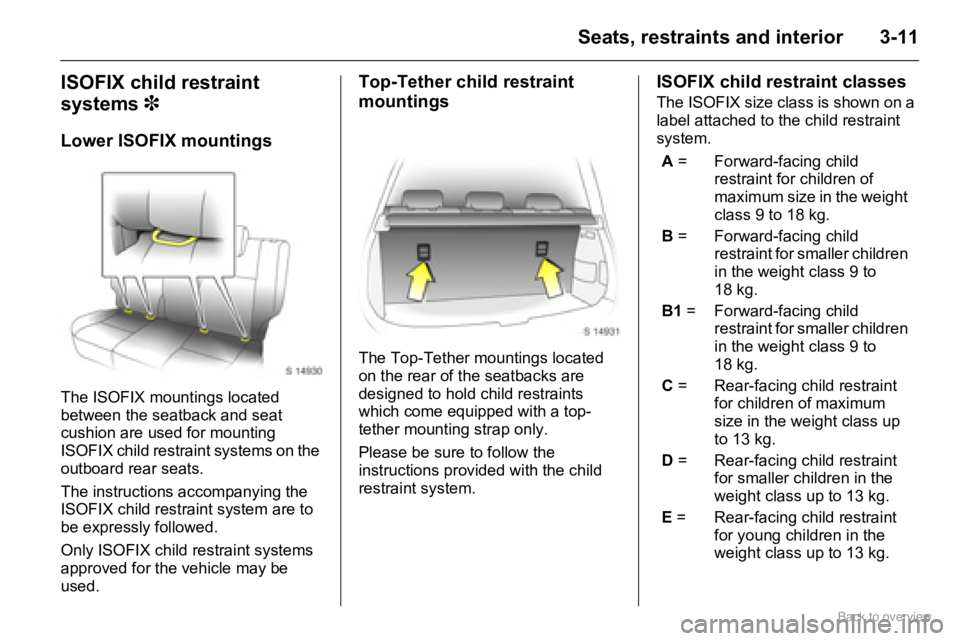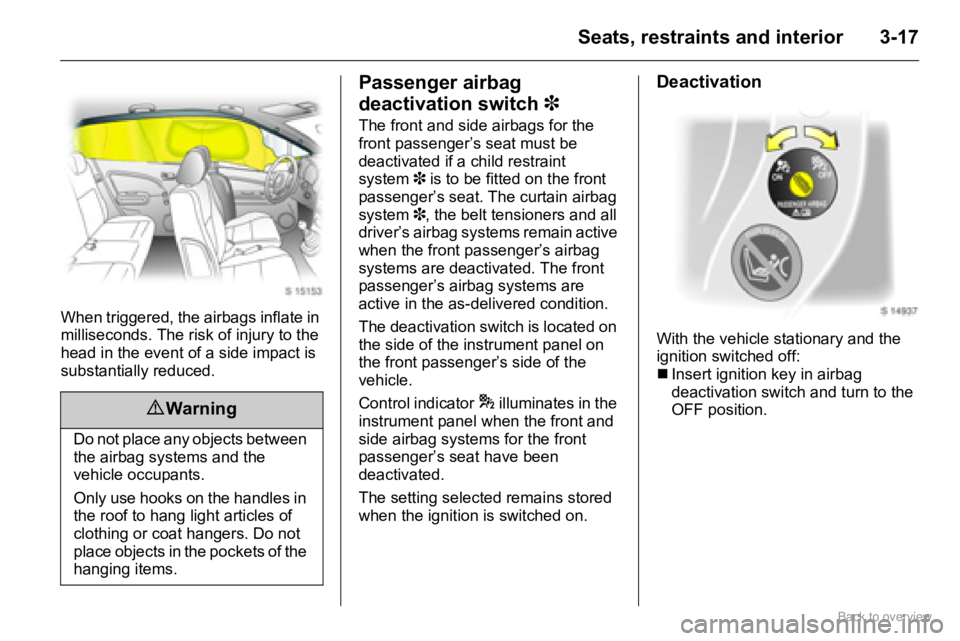2009 OPEL AGILA child restraint
[x] Cancel search: child restraintPage 27 of 153

3-1Seats, restraints and interior
Seats, restraints
and interiorHead restraints
Head restraint position
For maximum protection, the middle
of the head restraint should be at eye
level. If this is not possible for
extremely tall persons, set to highest
position, and set to lowest position for
extremely small persons.
Height adjustment
To adjust head restraint height, press
catch, adjust height to suit then
release the catch.
Removal
Press catch. Pull up and remove the
head restraint.
Stow head restraints securely in
luggage compartment. Head restraints ..................... 3-1
Front seats ............................ 3-2
Rear seats ............................ 3-3
Seat belts .............................. 3-5
Child restraints ...................... 3-9
Airbag system ....................... 3-13
9 Warning
Only drive with head restraints
correctly adjusted.
Page 32 of 153

3-6 Seats, restraints and interior
In the event of an accident, persons
not wearing seat belts endanger their
fellow occupants and themselves.
Control indicator X for driver’s seat
belt reminder 35-9.
Seat belts are designed to be used by
only one person at a time. They are
only suitable for children aged up to
12 years or smaller than 150 cm if
used in conjunction with a child
restraint 3.
Belt force limiters
Load limiters on the front seats
reduce the impact on the seat
occupant’s body from a tensioning
belt, in the event of frontal collisions
or rear impacts of a certain severity.
The belt force is controlled, to reduce
the risk of belt-inflicted injury.
Belt tensioners
The seat belt systems on the front
seats incorporate belt tensioners
housed in the belt buckles and seat
belt retractors.
In the event of frontal collisions or
rear impacts of a certain severity, belt
buckles and seat belt retractors
tighten the seat belts; the shoulder
and lap belts are instantaneously
tightened to fit the occupant’s body
more snugly.The belt tensioners actuate only once
and must be replaced after activation.
Seek the assistance of a workshop.
�„The belt tensioners only actuate
once, indicated by continuous
illumination of control indicator v in
the instrument cluster 35-9.
Deployed belt tensioners must be
replaced. Seek the assistance of a
workshop.
�„Accessories not released for your
vehicle type and other objects must
not be fixed or placed within the
action zone of the belt tensioners,
as they may result in injury if the
belt tensioners are triggered.
9 Warning
Always wear your seat belt, also
in urban traffic and when you are
a rear seat passenger. It can save
your life!
9 Warning
Improper handling (e.g. removal
or installation) can activate the
belt tensioners.
Page 35 of 153

3-9Seats, restraints and interior
Child restraints
Child restraint systems 3
When a child restraint system is
being used, pay attention to the
following usage and installation
instructions and also those supplied
with the child restraint system.
The country in which you are driving
could require the use of child restraint
systems at specific seats. Follow all
local and national regulations.Selecting the right system
Your child should be transported
facing rearwards in the vehicle for as
long as possible. It is appropriate to
change the system when the child’s
head can no longer be properly
supported at eye height. The child’s
cervical vertebrae are still very weak
and in an accident they suffer less
stress in the semi-prone rearward
position than when sitting upright.
�„Children under 12 years or under
150 cm tall should only travel in an
appropriate child safety seat.
�„Never carry a child whilst travelling
in the vehicle. The child will
become too heavy to hold in the
event of a collision.
�„When transporting children, use a
child restraint system that is
suitable for the child's weight, age
and height.
�„Ensure that the child restraint
system to be installed is compatible
with the vehicle type.
�„Ensure that the mounting location
of the child restraint system within
the vehicle is correct.�„Only allow children to enter and exit
the vehicle at the side facing away
from the traffic.
�„When the child restraint system is
not in use, secure the seat with a
seat belt or remove it from the
vehicle.
�„A child restraint system which has
been subjected to stress in an
accident must be replaced.
�„Opel produce a range of child
restraint systems. We recommend
you consult an Opel Service
Partner.
9 Warning
When using a child restraint
system on the front passenger’s
seat, the airbag systems for the
front passenger’s seat must be
deactivated; if not, the triggering
of the airbags poses a risk of fatal
injury to the child.
This is especially the case if rear-
facing child restraint systems are
used on the front passenger’s
seat.
Page 36 of 153

3-10 Seats, restraints and interior
Child restraint installation locations
X = Seat position not suitable for children in this mass group.
U = Suitable for ’universal’ category child restraints, attached with the vehicle seat belt, approved for use in this mass group. Mass group Front passenger’s seat Outboard rear
seatsCentre rear seat
airbags
activatedairbags
deactivated
Group 0: up to 10 kg
or approx. 10 months X U
1)
1)Only if front passenger’s seat airbag systems are deactivated 3 3 3-17.
Seat height 3 must be in its uppermost position 3 3-3.
Group 0 and 0+: Front passenger’s seat must be in its rearmost position 3 3-2.
Group I: When attaching child restraints by means of three-point seat belts, seat belt must run forwards from the anchorage point 3 3-8.
U2)
2)Seat location with ISOFIX mountings available 3 3-11.
X
Group 0+: up to 13 kg
or approx. 18 months X U
1) U2)X
Group I: 9 to 18 kg
or approx. 1 to 4 years X U
1) U2)X
Group II: 15 to 25 kg
or approx. 3 to 7 years X X U X
Group III: 22 to 36 kg
or approx. 6 to 12 years X X U X
Page 37 of 153

3-11Seats, restraints and interior
ISOFIX child restraint
systems 3
Lower ISOFIX mountings
The ISOFIX mountings located
between the seatback and seat
cushion are used for mounting
ISOFIX child restraint systems on the
outboard rear seats.
The instructions accompanying the
ISOFIX child restraint system are to
be expressly followed.
Only ISOFIX child restraint systems
approved for the vehicle may be
used.
Top-Tether child restraint
mountings
The Top-Tether mountings located
on the rear of the seatbacks are
designed to hold child restraints
which come equipped with a top-
tether mounting strap only.
Please be sure to follow the
instructions provided with the child
restraint system.
ISOFIX child restraint classes
The ISOFIX size class is shown on a
label attached to the child restraint
system.
A = Forward-facing child
restraint for children of
maximum size in the weight
class 9 to 18 kg.
B = Forward-facing child
restraint for smaller children
in the weight class 9 to
18 kg.
B1 = Forward-facing child
restraint for smaller children
in the weight class 9 to
18 kg.
C = Rear-facing child restraint
for children of maximum
size in the weight class up
to 13 kg.
D = Rear-facing child restraint
for smaller children in the
weight class up to 13 kg.
E = Rear-facing child restraint
for young children in the
weight class up to 13 kg.
Page 38 of 153

3-12 Seats, restraints and interior
Permissible options for fitting an ISOFIX child restraint system
IL = Suitable for particular ISOFIX restraint systems of the ‘specific-vehicle’, ‘restricted’ or ‘semi-universal’ categories. The
ISOFIX restraint system must be approved for the specific vehicle type.
IUF = Suitable for ISOFIX forward-facing child restraint systems of universal category approved for use in this mass group.
- = No ISOFIX mounting locations available at this location.Mass group ISOFIX size
classFixture Front
passenger’s seatOutboard rear
seatsCentre rear
seat
Group 0: up to 10 kg
or approx. 10 months E ISO/R1 - IL -
Group 0+: up to 13 kg
or approx. 18 months E ISO/R1 - IL -
DISO/R2 - IL -
CISO/R3 - IL -
Group I: 9 to 18 kg
or approx. 1 to 4 years D ISO/R2 - IL -
CISO/R3 - IL -
B ISO/F2 - IL, IUF
1)
1)Head restraint must be in its uppermost locking position or removed and stowed securely in luggage compartment.
-
B1 ISO/F2X - IL, IUF
2)
2)Head restraint must be removed and stowed securely in luggage compartment.
-
A ISO/F3 - IL, IUF
1)-
Page 40 of 153

3-14 Seats, restraints and interior
The front airbag system will be
triggered depending on the severity
of the accident, and within the range
shown in the illustration.
The ignition must be switched on.When triggered, the airbags inflate in
milliseconds. Forward movement of
the driver and front passenger is
checked and the risk of injuries to the
upper body and head are thereby
substantially reduced.9 Warning
The front airbag system provides
optimum protection when the
seat, seat belt, seatback and
head restraint are correctly
adjusted as described 33-1 to
3-5.
Do not place objects, children or
pets in the area in which the
airbags inflate.
Page 43 of 153

3-17Seats, restraints and interior
When triggered, the airbags inflate in
milliseconds. The risk of injury to the
head in the event of a side impact is
substantially reduced.
Passenger airbag
deactivation switch 3
The front and side airbags for the
front passenger’s seat must be
deactivated if a child restraint
system3 is to be fitted on the front
passenger’s seat. The curtain airbag
system3, the belt tensioners and all
driver’s airbag systems remain active
when the front passenger’s airbag
systems are deactivated. The front
passenger’s airbag systems are
active in the as-delivered condition.
The deactivation switch is located on
the side of the instrument panel on
the front passenger’s side of the
vehicle.
Control indicator* illuminates in the
instrument panel when the front and
side airbag systems for the front
passenger’s seat have been
deactivated.
The setting selected remains stored
when the ignition is switched on.
Deactivation
With the vehicle stationary and the
ignition switched off:
�„Insert ignition key in airbag
deactivation switch and turn to the
OFF position.
9 Warning
Do not place any objects between
the airbag systems and the
vehicle occupants.
Only use hooks on the handles in
the roof to hang light articles of
clothing or coat hangers. Do not
place objects in the pockets of the
hanging items.